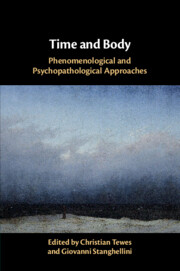Book contents
- Time and Body
- Endorsements for Time and Body
- Time and Body
- Copyright page
- Dedication
- Additional material
- Contents
- Figures
- Contributors
- 1 Introduction – Time and Body
- 2 Time, the Body, and the Other in Phenomenology and Psychopathology
- Part I Body and Time: General Aspects
- Part II Grief and Anxiety
- Part III Borderline Personality and Eating Disorders
- 9 Emotion Regulation in a Disordered World
- 9.1 Commentary on “Emotion Regulation in a Disordered World: Understanding Borderline Personality Disorder”
- 10 Nobody? Disturbed Self-Experience in Borderline Personality Disorder and Four Kinds of Instabilities
- 10.1 Commentary on “Nobody? Disturbed Self-Experience in Borderline Personality Disorder and Four Kinds of Instabilities”
- 11 Levels of Embodiment
- 11.1 Commentary on “Levels of Embodiment: A Husserlian Analysis of Gender and the Development of Eating Disorders”
- 12 Phenomenology of Corporeality (and Spatiality) in Anorexia Nervosa with a Reference to the Problem of Its Temporality
- 12.1 Commentary on “Phenomenology of Corporeality (and Spatiality) in Anorexia Nervosa with a Reference to the Problem of Its Temporality”
- Part IV Depression, Schizophrenia, and Dementia
- Index
- References
10.1 - Commentary on “Nobody? Disturbed Self-Experience in Borderline Personality Disorder and Four Kinds of Instabilities”
Who? Nobody? The Existence of Flesh
from Part III - Borderline Personality and Eating Disorders
Published online by Cambridge University Press: 30 October 2020
- Time and Body
- Endorsements for Time and Body
- Time and Body
- Copyright page
- Dedication
- Additional material
- Contents
- Figures
- Contributors
- 1 Introduction – Time and Body
- 2 Time, the Body, and the Other in Phenomenology and Psychopathology
- Part I Body and Time: General Aspects
- Part II Grief and Anxiety
- Part III Borderline Personality and Eating Disorders
- 9 Emotion Regulation in a Disordered World
- 9.1 Commentary on “Emotion Regulation in a Disordered World: Understanding Borderline Personality Disorder”
- 10 Nobody? Disturbed Self-Experience in Borderline Personality Disorder and Four Kinds of Instabilities
- 10.1 Commentary on “Nobody? Disturbed Self-Experience in Borderline Personality Disorder and Four Kinds of Instabilities”
- 11 Levels of Embodiment
- 11.1 Commentary on “Levels of Embodiment: A Husserlian Analysis of Gender and the Development of Eating Disorders”
- 12 Phenomenology of Corporeality (and Spatiality) in Anorexia Nervosa with a Reference to the Problem of Its Temporality
- 12.1 Commentary on “Phenomenology of Corporeality (and Spatiality) in Anorexia Nervosa with a Reference to the Problem of Its Temporality”
- Part IV Depression, Schizophrenia, and Dementia
- Index
- References
Summary
Schmidt (2021) convincingly describes three kinds of instabilities (in identity, affect, and interpersonal relationship) associated with the borderline personality disorder (BPD) and shows how these phenomena are related with body experience. Schmidt argues that all these types of instabilities are experientially interrelated and demonstrates this by providing examples that show how disturbed self-experience is involved in identity, affect, and intersubjective instability. In the light of these descriptions, he suggests that there is a fourth kind of instability in BPD patients that specifically concerns embodiment.
- Type
- Chapter
- Information
- Time and BodyPhenomenological and Psychopathological Approaches, pp. 230 - 233Publisher: Cambridge University PressPrint publication year: 2020

